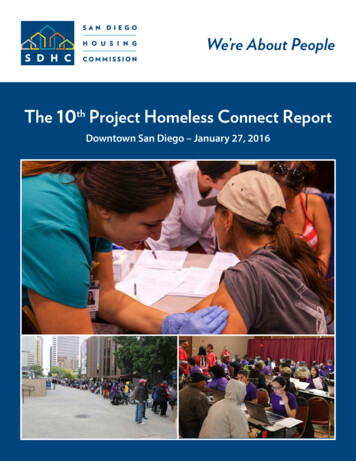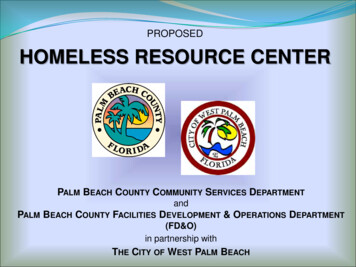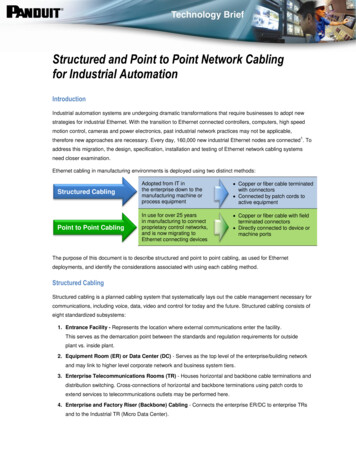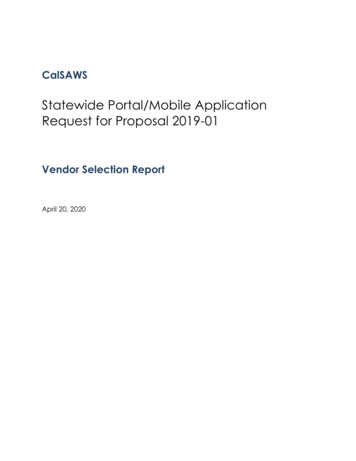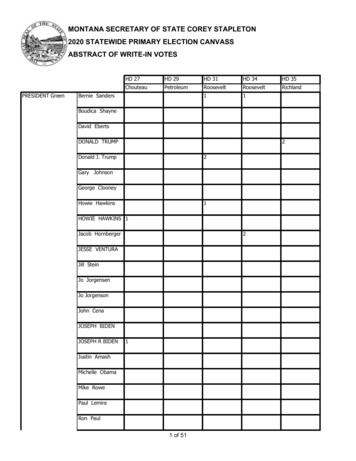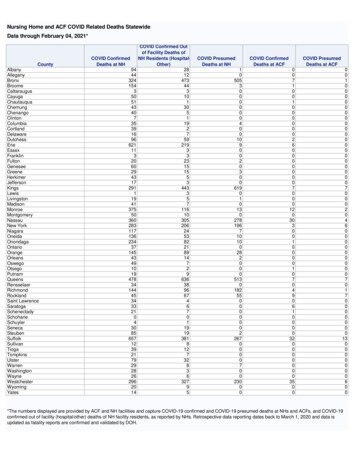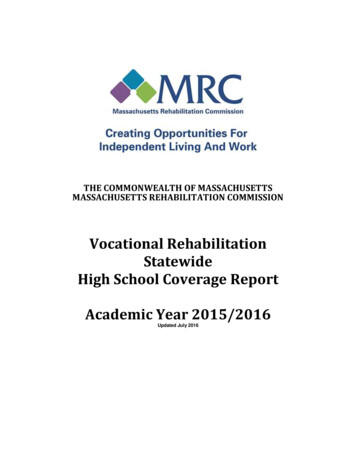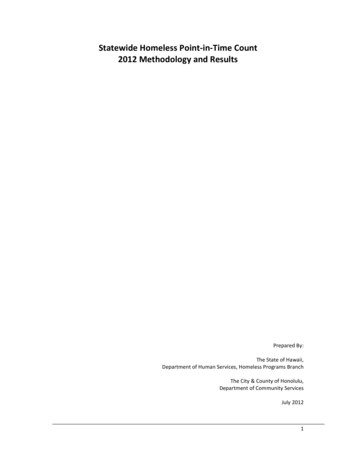
Transcription
Statewide Homeless Point-in-Time Count2012 Methodology and ResultsPrepared By:The State of Hawaii,Department of Human Services, Homeless Programs BranchThe City & County of Honolulu,Department of Community ServicesJuly 20121
Table of ContentsAcknowledgments3-4Background and Project Overview5-7Overview of 2012 Results8-10Statewide Sheltered Homeless Counts11Sheltered Homeless Demographic Characteristics, 2012 PIT12-13Sheltered and Unsheltered Homeless Subpopulations14-15Statewide Unsheltered Homeless Counts16-17Regional Changes of Unsheltered Homelessness18-19Demographic Characteristics of the 2012 Unsheltered Adult Population20-21Unsheltered Chronically Homeless Counts22-24Recommendations for Future PIT Counts25-27PIT Count Execution28Appendix 1: Emergency and Transitional Shelter Listings29-30Appendix 2: CoC Summaries and Subpopulation Data2
31-34Appendix 3: Site of Interview Analysis35-42Appendix 4: Unaccompanied Chronic Homeless Crosstabs43-48Appendix 5: 2012 PIT Count Household Survey49-50Appendix 6: 2012 PIT Count Single Survey51-52Appendix 7: 2012 Unsheltered PIT Count Materials to Surveyors53Appendix 8: Statement of Confidentiality54-553
AcknowledgementsMahalo to the agencies and individuals who contributed their time, expertise, gifts for personsexperiencing homelessness, and other resources to conduct the 2012 Statewide Homeless Point-in-TimeCount (PIT). The City & County of Honolulu and the Department of Human Services would like torecognize the following persons, organizations, and public and private agencies for participating in thisproject:Partners in Care Point in Time Planning Members Gabriel Naeole – City & County of Honolulu, Department of Community ServicesLori Tsuhako – State of Hawaii, Department of Human Services, Homeless Programs OfficeDarlene Hein – Waikiki Health CenterTien Lum – Hybrid International, LLCCarlos Peraro – C. Peraro Consulting, LLCPartners in Care is a coalition of representatives on Oahu and Bridging the Gap a coalition representingthe rural counties. Both coalitions include service providers, state and local government, communitygroups, and homeless and formerly homeless individuals that are providing a comprehensivecollaborative response to the diverse needs of individuals and families experiencing homelessness.Bridging the Gap Point in Time Planning Members Rita Sandi-Palma, Chair – Community Alliance Partners (Big Island CoC)Jeremy McComber – Hawaii County Office of Housing and Community DevelopmentDebra deLuis, Chair – Kauai Community Alliance (Kauai CoC)Sharon Woodward– Kauai Housing AgencyMaude Cumming, Chair – Maui Homeless Alliance (Maui CoC)Jan Shishido and Tina Krau – Maui County Department of Housing and Human ConcernsThank you to the numerous individuals and agencies donating gifts for persons and families experiencinghomelessness that were distributed during the Point-in-Time Count and to the many volunteers thathelped coordinate and carry out the interviews and count.Affordable Housing and Homeless AllianceCoordinators: Doran Porter, Catherine Datuin, Paul RuddellFamily Life CenterCoordinator: Maude CummingHale Kipa, Inc.Coordinator: Alika CampbellIHS, the Institute for Human Services, Inc.Coordinator: Connie MitchellKalihi-Palama Health CenterCoordinator: Aaron WhyneKauai Economic OpportunityCoordinator: Stephanie Fernandes4
Ka Hale A Ke OlaCoordinator: Mike DavisOffice for Social MinistryCoordinator: Brandee MeninoSalvation Army, MauiCoordinators: Captains Kathy and Mark MerrittUnited States Veterans InitiativeCoordinator: Will FordWaianae Coast Comprehensive Health CenterCoordinator: Theresa GonsalvesWaianae Community OutreachCoordinators: Tulu Toa and Laura PitoloWaikiki Health CenterCoordinators: Darlene Hein, Paul Oshiro, and Savina SteimloskFeed My SheepGregory House ProgramsHale Kau KauHawaii Helping the Hungry Have HopeHawaii Pacific University – School of NursingHawaiian HopeHelping Hands HawaiiMental Health KokuaSteadfast Housing Development CorporationUniversity of Hawaii – School of NursingVeterans Administration – Homeless Programs5
Background and Project OverviewThe U.S. Department of Housing and Urban Development’s (HUD) annual grant application for Continuumof Care (CoC) Homeless Assistance Programs funding requires the Honolulu and Balance of State Continuato produce “statistically reliable, unduplicated counts or estimates of homeless persons in sheltered andunsheltered locations on a one-day point in time.” The 2012 Statewide PIT Count date was January 23,2012.The City & County of Honolulu, Department of Community Services (DCS), the State of Hawaii,Department of Human Services (DHS), Homeless Programs Office, Bridging the Gap CoC, and Partners inCare CoC collaborated to develop the methodology for the count and worked diligently with homelessservice providers to plan the logistics and develop the survey instruments in accordance with HUD’sguidelines.ObjectivesThe objective of the 2012 PIT Count was to obtain an accurate estimate of Oahu’s sheltered andunsheltered homeless populations on January 23, 2012 in conjunction with: Obtaining an overall count of homeless individuals and households in specific subpopulations in theCity & County of Honolulu;Obtaining an estimate of the number of homeless singles and persons in households with children;Obtaining an estimate of the number of chronically homeless individuals and families according toHUD’s definition of “chronically homeless.”As in the 2011 PIT Count, the State of Hawaii’s Homeless Management Information System (HMIS) wasutilized to extract data for both the sheltered and unsheltered counts. The HMIS is a statewide databasethat was established in 2002 for recording homeless client and service data in an accurate and uniformmanner in order to track program outputs and outcomes for reporting and funding purposes. Allhomeless service providers receiving funding through the City, State, or HUD are required to participate inthe HMIS. Some privately funded agencies voluntarily use the HMIS.The State received HUD’s permission to deviate from the conventional one-night PIT Count methodologyand to instead conduct a six-day unsheltered physical count from Tuesday, January 24, 2012 to Sunday,January 29, 2012. These dates fell within the last ten days of January 2012 as mandated by HUD. Allunsheltered persons encountered by field staff were asked “Where did you sleep this past Monday,January 23?” as well as other survey questions.The unsheltered homeless count used survey instruments based on criteria from HUD’s Guide to CountingUnsheltered Homeless for use by field staff to document unsheltered responses. The surveys forunsheltered persons on the night of January 23, 2012 were entered into the PIT Count module of theHMIS, which has response fields for all of the survey questions. The surveyed participant’s name was firstqueried in the HMIS to determine whether the person had ever been entered into the HMIS database.Surveyed respondents determined to be in the HMIS database had pieces of their demographicinformation populate the corresponding response fields to streamline the data entry process. Staffperforming data entry had the opportunity to edit the populated fields if the information was not current.After all surveys were entered into the PIT module, the data were exported into Excel in order to obtainthe statistics mandated by HUD and contained in this report.The following unsheltered encounters were not included in the unsheltered homeless count: 1) personswho stated that they had been sheltered on the night of January 23, 2012, 2) persons who wereapproached to complete a survey but refused, 3) persons who were approached to complete a survey but6
indicated that they had already been surveyed, and 4) persons who did not indicate where they had slepton January 23, 2012.The vast majority of the sheltered homeless count was derived from HMIS client and intake data in theSheltered Programs section of the HMIS for the night of January 23, 2012. Emergency shelters andtransitional housing programs were contacted prior to this date and instructed that all clients sleeping intheir facility on the night of the count needed to have active intakes in the HMIS. Furthermore, agencieswere advised to make sure that all client and intake data were up to date. Follow-up with specific serviceproviders was also conducted to verify that the HMIS listing matched the nightly census. Shelters notparticipating in the HMIS (such as domestic violence shelters) were contacted individually to provide thenumber of homeless individuals and families residing at their shelters on the night of the count, inaddition to providing specific subpopulation data.PIT Count planning meetings were conducted prior to the night of the count and were attended by stafffrom DCS, the DHS Homeless Programs Branch, PIT Team Coordinators, the contracted data analyst, andinterested Bridging the Gap and Partners in Care members. The purpose of these meetings was to refinethe count’s methodology, provide instructions, and obtain feedback regarding the survey instrumentsused for the unsheltered counts. The survey instruments are attached as Appendices 5 and 6.Point-in-Time Count TeamsPIT Count Teams were composed of outreach workers from service agencies that regularly performoutreach to unsheltered individuals and families experiencing homelessness on Oahu and the ruralcounties. Teams were assigned to a region where they regularly provide outreach services so field staffcould use their familiarity with the region to ensure all of the areas frequented by unsheltered homelesspopulations were surveyed. Because outreach workers had already established rapport with many of theconsumers they encountered, consumers were more likely to participate in the surveys.The regions where unsheltered persons reported sleeping on the night of the count were categorizedbelow for each of the four islands. Each household belonged to exactly one of the regions on each of theislands. Analysis for the unsheltered counts is presented in the unsheltered sections of this report.Sheltered breakdowns for the Oahu regions are presented in appendix one. Sheltered breakdowns byisland for the rural county are also detailed in appendix oneOahu Regions:1. Downtown Honolulu: Salt Lake to Piikoi Street;2. East Honolulu: Piikoi Street to Hawaii Kai, including Waikiki;3. Ewa: Aiea to Kapolei;4. Kaneohe to Waimanalo;5. Wahiawa to North Shore;6. Upper Windward: Kahaluu to Kahuku; and7. Waianae Coast.Maui Regions:1. Central Maui2. Lower Waiehu3. Up Country4. Lahaina5. Kihei6. HanaKauai Regions:7
12345WestSouthSouth CentralEastNorthHawaii Regions:1. Puna2 Hilo3 Hamakua4 Kohala5 Kona6 KauImplementationThe sheltered PIT count was on Monday, January 23 and the unsheltered count was from January 24-29,2012. A “Super Wednesday” unsheltered count was conducted with all participating agencies on thenight of January 25, 2012, aimed at reaching as many unsheltered persons as possible. For thesubsequent five days of the unsheltered count, each outreach agency independently scheduled days andtimes when field staff would visit known sites, balancing safety with timing in an effort to maximize thenumber of unsheltered persons counted.While the 2005 and 2007 PIT Counts used a sampling method to survey the encountered homeless, the2009, through 2012 HMIS PIT Count Methodology required that all unsheltered persons identified beasked to complete a survey. Service providers agreed this was the best way to get an accurate count ofhomeless persons and an improved chronically homeless tally. This also allowed field staff to obtain aname and/or unique identifying description for each person being counted so the surveyed persons couldbe unduplicated with confidence. Unduplicating the data is important to ensure clients or families thatmistakenly appear multiple times in the counts are only counted once.The duration of the count was increased to six days so outreach teams could survey each personencountered and to give field staff more time to reach as many unsheltered persons as possible. Serviceproviders also felt that surveying the encountered homeless, rather than using a sampling method,provides a better estimate of homeless subpopulation information.8
Overview of 2012 ResultsOn January 23, 2012 the Honolulu (HI-501) and Balance of State (HI-500) Continua conducted a one-daysheltered count of homeless persons on Oahu and the rural counties (Maui, Kauai, and Hawaii)respectively. This sheltered count preceded a six-day unsheltered tally of homeless persons from January24 to 29, 2012, which spanned the entire islands of Oahu, Maui, Kauai, and Hawaii.Exhibit 1a summarizes the Oahu count of sheltered and unsheltered persons. The sheltered PIT countincluded persons staying in emergency, transitional, or safe havens. Combined, the counts estimated thetotal number of people who are homeless on the island of Oahu to be 4,353 persons. Shelteredaccounted for 3,035 and unsheltered 1,318. Individuals are defined to be single persons or persons in ahousehold without children; a couple is an example of this scenario. As illustrated in the table, 29% of thetotal sheltered persons were individuals, while the remaining 71% were persons in families. Persons infamilies are defined as being a household with at least one adult and at least one child. Roughly 87% ofthe unsheltered persons were individuals while 13% were persons in families for the island of Oahu.Exhibit 1a – Oahu Homeless Persons and Households by Sheltered Status, 2012 PITCountHousehold TypeTotal dUnshelteredTotalPersons in FamiliesShelteredUnshelteredTotalTotal Family HouseholdsShelteredUnshelteredTotalNumber of Homeless% of 592.9%7.1%100.0%As shown in exhibit 1a, sheltered homeless persons on Oahu comprised 70% of the total homeless, whileunsheltered persons were roughly 30%. The ratio of sheltered family households to unsheltered familyhouseholds was about thirteen to one.Exhibit 1b below summarizes the rural counties PIT count of sheltered and unsheltered persons.Combined, the counts estimated the total number of people who are homeless on rural counties to be1,893 persons. Sheltered accounted for 691 and unsheltered 1,202. As illustrated in the table, 30% of thetotal sheltered persons were individuals, while the remaining 70% were persons in families. This wasnearly identical to the proportion for Oahu. Roughly 76% of the unsheltered persons were individualswhile 24% were persons in families for the rural counties. The proportion of the unsheltered that waspersons in families for the rural counties were nearly two times that of Oahu.9
Exhibit 1b – Rural Counties Homeless Persons and Households by Sheltered Status,2012Household TypeTotal dUnshelteredTotalPersons in FamiliesShelteredUnshelteredTotalTotal Family HouseholdsShelteredUnshelteredTotalNumber of Homeless% of 2.3%100.0%As shown in exhibit 1b, sheltered homeless persons in the rural counties comprised 37% of the totalhomeless, while unsheltered persons covered roughly 64%. The ratio of sheltered family households tounsheltered was about two to one and significantly lower than that of Oahu. This is also due to thesmaller inventory of family unit space in the rural counties.Exhibits 2a through 2d illustrate the changes in PIT counts for the four major islands making up the 2012count. The tables span the last four years (2009-2012) and breakout the number of homeless bysheltered status and household type. The sheltered status is divided into sheltered and unshelteredhomeless, and the household type is grouped into individuals and persons in families. The last column ineach of the tables calculates the percentage change in each row over the 2011 and 2012 counts.Exhibit 2a – Changes in the PIT Counts of Homeless Persons for Oahu, 2009 – 2012Sheltered StatusShelteredUnshelteredHousehold TypeIndividualsPersons inFamiliesTotal2009201020112012% Change 201120122,4451,1932,7971,3742,9121,3223,0351,318 4.2%-0.3%1,8121,8261,9542,2171,9992,2352,0092,344 0.5% 4.9%3,6384,1714,2344,353 2.8%Exhibit 2b – Changes in the PIT Counts of Homeless Persons for Maui, 2009 – 2012Sheltered StatusShelteredUnshelteredHousehold Type2009201020112012422581392399394658420454% Change 20112012 6.6%-31.0%10
IndividualsPersons %1,0037911,052874-16.9%Exhibit 2c – Changes in the PIT Counts of Homeless Persons for Kauai, 2009 – 2012Sheltered StatusShelteredUnshelteredHousehold TypeIndividualsPersons inFamiliesTotal2009201020112012% Change 20112012801256021397239101301 4.1% 25.9%12184166107191145229173 19.9% 19.3%205273336402 19.6%Exhibit 2d – Changes in the PIT Counts of Homeless Persons for Hawaii, 2009 – 2012Sheltered StatusShelteredUnshelteredHousehold TypeIndividualsPersons inFamiliesTotal2009201020112012% Change 20112012321615286313229337170447-25.8% 32.6%428508296303345221368249 6.7% 12.7%936599566617 9.0%As illustrated above, the sheltered homeless count on Oahu has risen each of the last four years. From2011 to 2012 Oahu’s emergency and transitional shelters saw a 4.2% increase in the total number ofsheltered homeless. When comparing the 2010 count to the 2012 count, the percentage increase is 8.5%.Over the three-year period from 2009 to 2012, the percentage change in the sheltered homeless was24.1%. This significant change is largely due to increased shelter capacity, especially along the Waianaecoast. Three of the four rural counties saw an increase in the total number of homeless from 2011 to2012. Maui was the only island that saw a drop in the total number of homeless since last year.Utilization rates for Oahu and the rural counties are presented in appendix one. The transitional housingoccupancy rates for the rural counties were significantly lower than Oahu for the night of the count. Allislands should strive to have their sheltered programs operating at or near capacity for the majority of theyear.11
The figure above denotes total homelessness by island over the last four years.12
Statewide Sheltered Homeless Counts1The sheltered homeless counts were exported from the sheltered section of the HMIS database for thenight of January 23, 2012. Shelters were contacted prior to this date and instructed to make sure that allclient and intake data in the HMIS was correctly entered and up-to-date. Follow-up was also conductedto ensure that the numbers were accurate for the day of the count.Shelters not participating in the HMIS (including domestic violence shelters) were contacted individuallyto provide all subpopulation data and the total number of homeless individuals and families residing attheir shelters on the night of the January 23, 2012. The results are shown in exhibit three. This exhibitalso displays the results from the last three counts whose methodology was the same.The table below is similar to exhibits 2a-d above; however, focus on filtering the sheltered row of theaforementioned tables. All counties except Hawaii show increases when compared to at least the lasttwo counts. Hawaii shows a continuous decline in the total number of sheltered homeless and can beattributed to low shelter utilization as defined in the second table of appendix one. Statewide shelterutilization slopes positively over the last four years. It appears that the 2013 shelter count will trendslightly higher. The statewide sheltered homeless total was 3,726 people, Oahu contributing to 81% ofthe total. Persons in families continue to comprise a high percentage of the sheltered total, the averagebeing just under 71% over the last four years
University of Hawaii – School of Nursing Veterans Administration – Homeless Programs. 6 Background and Project Overview The U.S. Department of Housing and Urban D

